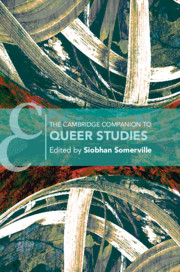Book contents
- The Cambridge Companion to Queer Studies
- The Cambridge Companion to Queer Studies
- Copyright page
- Dedication
- Contents
- Figures
- Contributors
- Acknowledgments
- Chronology
- Introduction
- Part I Genealogies
- Part II Confluences
- Part III Representation
- Chapter 8 Queer Poetics
- Chapter 9 Queer Narrative
- Chapter 10 Trace a Vanishing, or Queer Performance Study
- Chapter 11 Queer and Trans Studies in Pop Culture
- Chapter 12 Queer Digital Cultures
- Part IV Key Words
- Index
- Cambridge Companions to …
- References
Chapter 11 - Queer and Trans Studies in Pop Culture
Transgender Tripping Points in the Carceral State
from Part III - Representation
Published online by Cambridge University Press: 02 June 2020
- The Cambridge Companion to Queer Studies
- The Cambridge Companion to Queer Studies
- Copyright page
- Dedication
- Contents
- Figures
- Contributors
- Acknowledgments
- Chronology
- Introduction
- Part I Genealogies
- Part II Confluences
- Part III Representation
- Chapter 8 Queer Poetics
- Chapter 9 Queer Narrative
- Chapter 10 Trace a Vanishing, or Queer Performance Study
- Chapter 11 Queer and Trans Studies in Pop Culture
- Chapter 12 Queer Digital Cultures
- Part IV Key Words
- Index
- Cambridge Companions to …
- References
Summary
This chapter presents queer and trans popular culture studies through a 2015 plotline on the US soap opera The Bold and the Beautiful, in which Maya Avant, a character introduced several years previously, is revealed to be a trans woman. I consider Maya’s story within both the specific context of the soap genre and the supposed phenomenon known as the “transgender tipping point” toward visibility and civil rights. Aiming to denaturalize argumentation as the goal of academic essays, I offer instead an analysis of Maya’s story in the service of a common fan cultural production: a new scenario dreamed up for the characters. Soap conventions normalize hidden pasts and bodily transformations, and B and B writers well used those conventions to de-scandalize trans genders. But they also evacuated and depoliticized Maya’s backstory. Maya first appeared on the show as a black woman newly released from unjust incarceration, separated from her child in the process, and struggling to survive in the heteropatriarchal, racist carceral state. I want B and B to revisit Maya’s history, dramatizing the role of mass incarceration in the lives of trans people, and particularly trans people of color.
Keywords
- Type
- Chapter
- Information
- The Cambridge Companion to Queer Studies , pp. 172 - 184Publisher: Cambridge University PressPrint publication year: 2020



